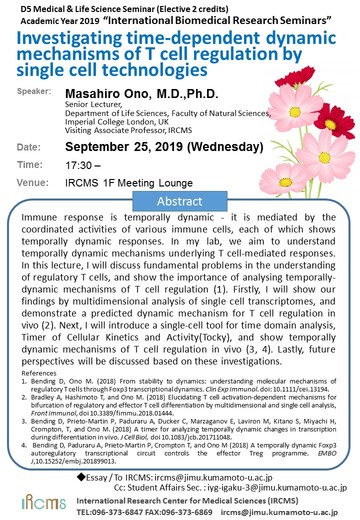- HOME
- News & Events
- [September 25] D5 Medical & Life Science Seminar - Dr. Masahiro Ono
News & Events
[September 25] D5 Medical & Life Science Seminar - Dr. Masahiro Ono
July 17 2019
The "D5 Medical & Life Science Seminar" course will be offered by International Research Center for Medical Sciences (IRCMS). It will run from April 2019 to March 2020, with lectures given by scientists who are affiliated with IRCMS or in collaboration with researchers at IRCMS. The lectures will be given once a month, in English, and by leading scientists in the relevant research field. Students will be taught: 1) how normal physiological functions are maintained in the human body; 2) how abnormalities in these systems (e.g., cancer) are studied using experimental models; 3) cutting-edge technologies (including single cell level imaging and omics analysis) used for mechanistic understanding of these abnormalities; 4) efforts and progresses in finding cure for human diseases associated with these abnormalities; and 5) importance of understanding disease mechanisms using cross-disciplinary approaches.
Date : September 25, 2019 (Wednesday)
Time : 17:30 -
Venue : IRCMS 1F Meeting Lounge
Speaker : Masahiro Ono, M.D.,Ph.D.
Senior Lecturer,
Department of Life Sciences, Faculty of Natural Sciences,
Imperial College London, UK
Visiting Associate Professor, IRCMS
Title : Investigating time-dependent dynamic mechanisms of T cell regulation by single cell technologies
Abstract :
Immune response is temporally dynamic - it is mediated by the coordinated activities of various immune cells, each of which shows temporally dynamic responses. In my lab, we aim to understand temporally dynamic mechanisms underlying T cell-mediated responses. In this lecture, I will discuss fundamental problems in the understanding of regulatory T cells, and show the importance of analysing temporally-dynamic mechanisms of T cell regulation (1). Firstly, I will show our findings by multidimensional analysis of single cell transcriptomes, and demonstrate a predicted dynamic mechanism for T cell regulation in vivo (2). Next, I will introduce a single-cell tool for time domain analysis, Timer of Cellular Kinetics and Activity(Tocky), and show temporally dynamic mechanisms of T cell regulation in vivo (3, 4). Lastly, future perspectives will be discussed based on these investigations.
References
- Bending D, Ono M. (2018) From stability to dynamics: understanding molecular mechanisms of regulatory T cells through Foxp3 transcriptional dynamics. Clin Exp Immunol. doi: 10.1111/cei.13194.
- Bradley A, Hashimoto T, and Ono M. (2018) Elucidating T cell activation-dependent mechanisms for bifurcation of regulatory and effector T cell differentiation by multidimensional and single cell analysis, Front Immunol, doi 10.3389/fimmu.2018.01444.
- Bending D, Prieto-Martin P, Paduraru A, Ducker C, Marzaganov E, Laviron M, Kitano S, Miyachi H, Crompton, T, and Ono M. (2018) A timer for analyzing temporally dynamic changes in transcription during differentiation in vivo. J Cell Biol, doi 10.1083/jcb.201711048.
- Bending D, Paduraru A, Prieto-Martin P, Crompton T, and Ono M (2018) A temporally dynamic Foxp3 autoregulatory transcriptional circuit controls the effector Treg programme. EMBO J,10.15252/embj.201899013.

